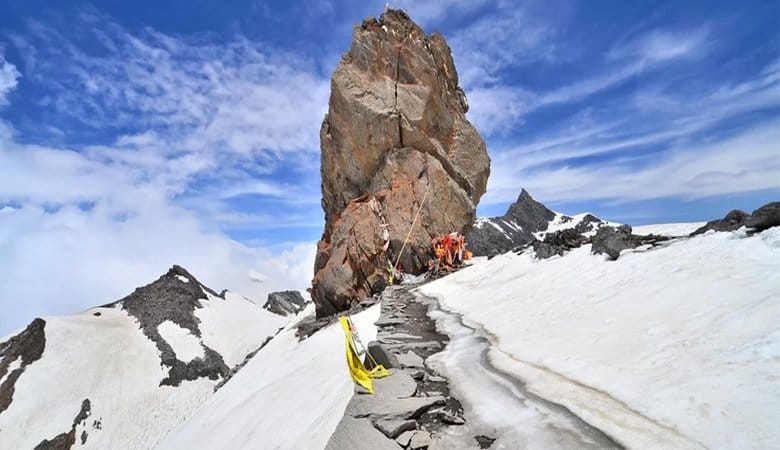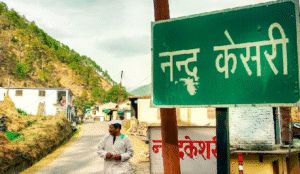Kinnaur Kailash – A Sacred Himalayan Pilgrimage

Mohit Bangari
Explore Himalaya With Me!!
Facebook
Email
WhatsApp
Twitter
LinkedIn
Tumblr

Kinnaur Kailash, also called Kinner Kailash, is one of the most sacred mountain peaks of the Himalayas. It is located in the Kinnaur district of Himachal Pradesh, very close to the Indo-Tibet border. The holy peak stands tall at an altitude of 6,050 metres above sea level, while the famous Kinnaur Shivling (the vertical rock pillar worshipped as Lord Shiva) rises at around 4,800 metres.
This mountain is worshipped by both Hindus and Buddhists. Hindus believe it is the winter abode of Lord Shiva and Goddess Parvati, while Buddhists consider it as a sacred seat of their deities. Local people of Kinnaur, called Kinners, also believe that this Kailash is no less powerful than Mount Kailash in Tibet.
The trek to Kinnaur Kailash is not just a physical journey but a test of faith, endurance, and devotion. It is counted among the five great Kailash pilgrimages of the Himalayas along with Adi Kailash, Shrikhand Mahadev, Kailash Mansarovar, and Manimahesh Kailash. Devotees strongly believe that completing the parikrama of Kinnaur Kailash gives punya equal to Kailash Mansarovar Yatra.
To understand the full spiritual picture, one must know about Panch Kailash, the five divine abodes of Lord Shiva in Himalayas. I have written a dedicated article on this topic where I have shared complete details of all five Kailash yatras. You can read it here – Panch Kailash: A Complete Guide to the Abodes of Lord Shiva.
Table of Contents
This region is also rich in culture and natural beauty. Apple orchards, snow-covered peaks, Buddhist monasteries, and the Sutlej River flowing through deep valleys make Kinnaur one of the most scenic destinations of Himachal Pradesh.
Location, Distances, and Coordinates
Kinnaur Kailash Peak Altitude: 6,050 metres
Kinnaur Shivling Altitude: 4,800 metres
Coordinates: 31.5344° N, 78.3842° E
District: Kinnaur, Himachal Pradesh
Base Town (Recong Peo): 2,290 metres altitude
Distances from Major Points
Shimla to Recong Peo: 230 km by road (9–10 hrs)
Chandigarh to Recong Peo: 335 km (10–12 hrs)
Delhi to Recong Peo: 590 km (15–16 hrs)
Recong Peo to Tangling village (Trek start point): 12 km by road
Tangling to Ashiqui Park: 10–12 km trek
Ashiqui Park to Shivling Rock: 8–10 km trek
Total Trek Distance (round trip): 40–45 km approx.
Manimahesh Kailash
This guide helps pilgrims journey to Manimahesh Kailash in Himachal,
considered Shiva’s sacred abode. It covers how to reach,
trek route details, best time to visit, and village culture around the lake. The language is clear
and practical—ideal for spiritual travellers and trekkers.
Click here
Nearest Facilities and Places
Nearest Airport: Shimla Jubbarhatti Airport (250 km)
Nearest Railway Station: Shimla Railway Station (230 km)
Nearest Big Town: Recong Peo (hotels, markets, and bus stand)
Nearest Hospital: Civil Hospital Recong Peo
Nearest Tourist Spots: Kalpa (famous for views of Kinnaur Kailash range), Sangla Valley, Chitkul (last Indian village), Nako Lake
Mythological Importance
According to Puranic legends, Lord Shiva and Goddess Parvati meditated at Kinnaur Kailash. Local folklore says that the giant Shivling stone changes its colour with the movement of the sun, which devotees take as a divine presence.
It is also believed that during the war between Lord Shiva and demon Bhasmasur, Shiva took shelter in this mountain. Locals consider the Shivling to be a direct symbol of Shiva and worship it with great devotion.
The Sacred Shivling
The vertical rock Shivling, about 79 feet high, is the main attraction of the trek. It stands on a mountain ridge at 4,800 metres and looks mystical in the backdrop of snow peaks. Pilgrims cover the last stretch barefoot, chanting mantras, as a mark of respect.
The Trek to Kinnaur Kailash
Trek Route with Distances
Tangling Village (2,400 m) – Starting point, 12 km from Recong Peo.
Tangling to Ashiqui Park (3,400 m): 10–12 km trek (6–8 hrs). Steep ascent through forests and rocky paths.
Ashiqui Park to Shivling Rock (4,800 m): 8–10 km trek (7–9 hrs). Very tough with glaciers, moraines, and vertical climbs.
Return Journey: Same way back to Tangling.
Expanded Trek Route (Day-wise)
The Kinnaur Kailash Shivling trek is considered one of the hardest pilgrimages in India. The route tests stamina, faith, and mental strength. Here is the detailed day-wise trekking route:
Day 1 – Tangling Village to Ashiqui Park
Starting Point: Tangling (2,400 m, 12 km from Recong Peo)
Distance: 10–12 km trek
Altitude Gain: About 1,000 metres
Time: 6–8 hours
The trek begins from Tangling village. The initial path passes through apple orchards, small streams, and green fields. After crossing these, the climb becomes steep with rocky paths and thick pine forests. The trail is narrow and zig-zag but very scenic. Pilgrims usually chant Shiva’s name while walking, and many local people play traditional instruments.
By evening, you reach Ashiqui Park (3,400 m). The place is a flat camping ground surrounded by alpine meadows. Pilgrims often rest here in tents. At night, one can see millions of stars, which creates a magical feeling of being close to Shiva.
Day 2 – Ashiqui Park to Shivling Rock and Return
Starting Point: Ashiqui Park (3,400 m)
Destination: Kinnaur Shivling Rock (4,800 m)
Distance: 8–10 km one way
Time: 7–9 hours (one way)
Altitude Gain: About 1,400 metres
This is the toughest stretch of the trek. The path goes through boulders, glaciers, and loose moraine. The slope is very steep, and oxygen becomes less at higher altitude. Many pilgrims walk barefoot in the final kilometre as a mark of devotion.
Shrikhand Mahadev Kailash
This article is a detailed guide for the Shrikhand Mahadev
Kailash yatra planned for 2025–26. It explains the
daily trekking itinerary, permit process, physical fitness tips, altitude
challenges, and the myth behind the sacred peak.
Everything is simple, clear, and written for both pilgrims and adventure lovers.
Click here
After a long climb, the Shivling Rock comes into view – a giant 79-feet natural vertical stone standing like a divine presence. People offer prayers, flowers, incense, and chant mantras here.
Pilgrims usually return the same day back to Ashiqui Park by evening. It takes another 5–6 hours to descend.
Day 3 – Ashiqui Park to Tangling Village
Distance: 10–12 km downhill
Time: 4–5 hours
The return journey is faster but requires careful walking as the trail is steep. Pilgrims reach Tangling by afternoon, completing the holy yatra.
Optional Route – Kinnaur Kailash Parikrama via Charang La
This is a 5–6 day trek covering around 60–70 km. It starts from Charang village, crosses the high Charang La Pass (5,300 m), and ends at Chitkul, the last Indian village near Tibet border. This parikrama is very sacred and considered as powerful as the Kailash Mansarovar parikrama.
Accommodation in Kinnaur Kailash Region
Accommodation depends on where you are halting. Facilities are simple but full of local hospitality.
1. Recong Peo & Kalpa
These are the main base towns before starting the trek.
You will find budget hotels, guest houses, and homestays.
Kalpa, about 13 km above Recong Peo, is famous for panoramic views of Kinnaur Kailash peaks. Many travellers prefer staying here for acclimatization.
Tariff: ₹800 – ₹2,000 per night for budget hotels, homestays are cheaper.
2. Tangling Village
Tangling is the starting point of the trek.
Only basic homestays and small dhabas are available.
Facilities are very simple: traditional mud houses, floor bedding, and home-cooked food.
Staying here gives you a chance to experience local Himachali hospitality.
3. On the Trek Route – Ashiqui Park
No permanent structures. Only tents are available during the yatra season (July–September).
Some tents are arranged by local organisers and yatra committees.
Pilgrims carry their own sleeping bags and mats.
Food is prepared in temporary kitchens (dal, chawal, roti, tea).
4. Charang La Parikrama Route
On this long route, accommodation is mostly camping and a few village homestays.
Pilgrims depend on dhabas set up by locals during the yatra.
Adi Kailash Yatra 2025-26 Itinerary
A complete itinerary for the upcoming Adi Kailash
Yatra (2025–26). This covers route options,
day-by-day schedule, altitude details, accommodation,
weather tips, and local highlights like pilgrimage
sites and views. Written simply so readers
can plan their spiritual journey with clarity and confidence.
Click here
Food Culture in Kinnaur Kailash Yatra
Food on the trek is simple, sattvic (pure vegetarian), and made with love. Alcohol and non-veg are strictly avoided in the yatra.
Local Himachali Food on the Trek
Dal, Chawal, Roti, Sabzi – the main meal at dhabas and homestays.
Rajma Chawal – a staple in Himachal, very popular in this region.
Madra – a traditional dish made with curd and chickpeas, usually served during special occasions.
Siddu – a local wheat bread filled with walnut paste or poppy seeds, steamed and eaten with ghee.
Thukpa & Momos – Tibetan influence due to proximity to Tibet.
Chilgoza (pine nuts) – a rare dry fruit found in Kinnaur, sometimes offered by locals.
Butter tea (Namkeen Chai) – a salty tea with butter, keeps the body warm at high altitude.
Food on Trek Route
On the trek route, food is very basic:
Morning: tea, paratha, or roti.
Lunch: packed puri-sabzi, bread with achar, or khichdi.
Evening: dal, chawal, sabzi, and tea.
Dry fruits, jaggery, chocolates, and glucose powder are carried by most yatris for instant energy.
Food Culture of Kinnaur Villages
The villages of Kinnaur follow mixed Hindu and Buddhist traditions. Their food is simple, mostly grain-based, and suited for cold climate. People rely on local produce like barley, rajma, peas, apples, and apricots. In homestays, you may get to taste local chutneys, apple wine (though avoided during yatra), and traditional pickles.
Another parikrama route is via Charang La Pass (5,300 m). It starts from Charang village and ends at Chitkul. Distance is approx 60–70 km and takes 5–6 days. This is considered equal to Kailash Mansarovar Parikrama.
Food & Accommodation Tips for Kinnaur Kailash Yatra
Since this yatra is tough and happens in a remote Himalayan region, planning your stay and food is very important. Here are some useful tips:
Tips for Accommodation
Book in Advance at Recong Peo or Kalpa: During yatra season, hotels and homestays fill up quickly. Pre-book if possible.
Choose Kalpa for Scenic Stay: If you want beautiful views of the Kinnaur Kailash range, stay at Kalpa instead of Recong Peo. Kalpa is quieter and more picturesque.
Tangling Village Stay: Do not expect hotels here. Stay in local homes or dhabas. It will be basic, but you will experience the real Kinnauri lifestyle.
Carry Your Own Tent/Sleeping Bag: Especially if you are planning parikrama or trekking without official organisers. On high camps like Ashiqui Park, tents are the only option.
Acclimatize Before Trek: Stay one night in Recong Peo or Kalpa before starting trek to avoid altitude sickness.
Tips for Food
Eat Light and Simple: Heavy oily food can make trekking difficult. Stick to dal, chawal, roti, and khichdi.
Carry Energy Food: Dry fruits, jaggery, chocolates, energy bars, and glucose powder are must. These help during steep climbs.
Hydration is Key: Always keep a water bottle. Use purification tablets or boil water when filling from natural streams.
Avoid Alcohol & Non-Veg: Both are strictly avoided in the yatra, and also not good for trekking in high altitude.
Try Local Specialties in Kalpa/Peo: Before or after trek, taste local dishes like siddu, rajma, madra, and Kinnauri apple-based items.
Tea Culture: Drink butter tea or normal chai frequently; it keeps body warm and gives quick energy.
General Advice
Pack light, but do not skip essentials like raincoat, woolens, and trekking shoes.
Always eat in moderation before trekking days; overeating can cause breathing problems in thin air.
Respect food customs – locals offer meals with devotion, finish your food and avoid wastage.
Trek Difficulty
The trek is very difficult. Steep altitude gain, lack of oxygen, and long climbing stretches make it suitable only for fit trekkers and serious pilgrims.
Best Time – Month-wise Calendar for Kinnaur Kailash Yatra
The yatra is not open throughout the year. It mainly happens during the summer–monsoon months when the snow melts and trails are accessible. Here’s the month-by-month breakdown:
May:
Trek route is mostly closed due to heavy snow. Only Recong Peo, Kalpa, and nearby valleys can be visited. Good time for sightseeing, not for yatra.
June:
Snow starts melting, lower trails become accessible. Weather is pleasant in Kalpa and Peo (10°C to 20°C). Trekking still risky in higher altitudes. Good for acclimatization and exploring Kinnaur villages.
July:
Official yatra season begins. Shivling trek opens. Temperature ranges between 5°C to 15°C. Trails are tough due to rain and slippery rocks. Pilgrims start the journey despite monsoon challenges.
August:
Peak yatra season. Thousands of devotees join the Kinnaur Kailash Yatra organised by local committees. Weather is unpredictable – heavy rains, landslides, and fog are common. Temperature between 4°C to 12°C at high altitude.
September:
Best month for trekking. Clear skies, stunning mountain views, stable weather, and less crowd compared to August. Temperature 0°C to 10°C near Shivling. This is the most recommended time for trekkers and photographers.
October:
The trek usually closes by the first week of October. Nights become extremely cold (below 0°C). Snowfall begins on higher ridges. Not suitable for pilgrims, but Kalpa and Sangla still good for sightseeing.
November to April:
Trek remains completely closed. Heavy snowfall, avalanches, and sub-zero temperatures make the route impossible. Only local villages are accessible.
Climate of Kinnaur Kailash
The climate of Kinnaur Kailash changes rapidly due to its high altitude. It is important to understand seasonal variations before planning the trek.
Summer (May – June): Lower villages like Kalpa and Recong Peo remain pleasant, with temperatures between 8°C to 20°C. But higher trek route still has snow, and trails remain partially closed. This is a good time for sightseeing but not ideal for the yatra.
Monsoon (July – August): This is the official Kinnaur Kailash Yatra season. Day temperature ranges between 5°C to 15°C. Nights are very cold, close to freezing. However, Kinnaur gets heavy monsoon rains which cause frequent landslides on roads. Trekking during this time is tough, but pilgrims still attempt it as organisers fix the yatra dates only in these months.
Post-Monsoon (September – early October): Clear skies, beautiful views, less rain, and stable weather. Temperature ranges between 0°C to 12°C. This is one of the best times for the trek, though yatra officially ends by September.
Winter (October – April): Extremely harsh climate with heavy snowfall. Temperature drops up to –15°C. Trek remains closed due to snow and risk of avalanches.
Kailash Mansarovar Yatra via Kumaon
Corridor Resumes in 2025
This article brings the latest update: the Kailash Mansarovar Yatra
via Kumaon Corridor resumes in 2025.
It details new routes, permit rules, health guidelines, travel tips,
and yatra packing list. A helpful update for
readers planning this sacred trip, delivered in simple, reader-friendly tone.
Click here
How to Reach Kinnaur Kailash
By Road: From Shimla → Rampur → Powari → Recong Peo → Tangling.
By Bus: HRTC buses run from Shimla, Chandigarh, and Delhi to Recong Peo.
By Taxi: Private taxis available from Shimla and Chandigarh.
By Air: Chandigarh Airport (350 km) is most connected. Shimla Airport (250 km) is closer but has limited flights.
By Train: Nearest broad-gauge station is Chandigarh. Narrow-gauge option is Kalka–Shimla toy train.
Tips for Pilgrims
Acclimatise in Recong Peo or Kalpa for at least a day before starting.
Carry warm clothes even in summer. Weather changes suddenly.
Walk slowly and drink enough water to avoid altitude sickness.
Respect local culture and avoid leather items, alcohol, and non-veg food during yatra.
Trekking pole, shoes, torch, and medical kit are compulsory.
Nearby Places to Visit around Kinnaur Kailash
If you are coming for Kinnaur Kailash Yatra, it is a good idea to explore the beautiful valleys and villages around. Kinnaur is famous for apple orchards, wooden temples, and untouched Himalayan culture. Here are some must-visit places:
1. Kalpa (7 km from Recong Peo)
A peaceful village with apple orchards and wooden houses. From Kalpa you get the most stunning views of Kinnaur Kailash range. The village also has the famous Narayan-Nagini temple and a Buddhist monastery.
2. Recong Peo
District headquarters of Kinnaur and the main town where you will halt before trek. It has markets, hotels, and monasteries. You can buy trekking gear, fruits, and local handicrafts here.
3. Roghi Village (8 km from Kalpa)
Known for its adventurous Roghi cliff road and traditional Kinnauri houses. The road is narrow but views are breathtaking.
4. Sangla Valley (40 km from Recong Peo)
Also called the Baspa Valley, Sangla is green and full of orchards. The Baspa river flows through, making it very scenic. Don’t miss Kamru Fort and Bering Nag Temple here.
5. Chitkul (60 km from Peo)
The last Indian village near the Tibet border. At 3,450 m height, it is surrounded by snow mountains and has a fairy-tale charm. The Baspa river, wooden temples, and traditional houses make it very special.
6. Nako Village (100 km from Recong Peo)
Famous for its beautiful Nako Lake and ancient monasteries. This small village feels like Tibet with its flat-roof houses and prayer flags.
7. Charang Village & Monastery
Located on the Charang La Parikrama route. The Charang Monastery is more than 1,000 years old and has deep Tibetan influence. It is one of the most spiritual places in Kinnaur.
8. Sarahan (110 km from Peo, towards Shimla)
Before entering Kinnaur, many pilgrims stop at Sarahan to visit the famous Bhimakali Temple, dedicated to Goddess Bhimakali. This temple is one of the 51 Shakti Peethas and very important for Hindu devotees.
Kinnaur Kailash vs Adi Kailash – Which One to Visit?
This comparison article helps readers choose
between Kinnaur Kailash and Adi Kailash yatra.
It compares difficulty level, spiritual importance,
trek distance, best season, accommodation, and views.
Written in simple Indian-style English, it guides readers to pick the pilgrimage
that suits their faith, fitness, and travel preferences.
Click here
FAQ about Kinnaur Kailash Yatra
Q1. Where is Kinnaur Kailash located?
Kinnaur Kailash is located in Kinnaur district of Himachal Pradesh, India, near the Indo-Tibetan border. The Shivling rock stands at an altitude of 4,800 metres (15,748 ft). The nearest town is Recong Peo, which is the district headquarters of Kinnaur.
Q2. How to reach Kinnaur Kailash?
Nearest Airport: Shimla Airport (250 km away)
Nearest Railway Station: Shimla (244 km)
Nearest Major Bus Stand: Shimla ISBT (Regular HRTC buses to Recong Peo)
From Recong Peo, one can take a taxi or bus to Tangling village (12 km), which is the base of the trek.
Q3. What is the total trek distance of Kinnaur Kailash Yatra?
The main yatra trek from Tangling to Shivling and back is about 30–35 km (round trip). The journey takes 3 days for normal pilgrims. The parikrama route via Charang La is about 60–70 km, requiring 5–6 days.
Q4. What is the altitude of Kinnaur Kailash Shivling?
The Shivling rock is located at 4,800 metres (15,748 ft). The trek involves a steep climb and is considered very challenging.
Q5. Do we need a permit for Kinnaur Kailash Yatra?
Yes. Since Kinnaur is close to the Indo-Tibetan border, an Inner Line Permit (ILP) is required for foreigners. Indian citizens usually do not need a permit for the main yatra, but for the Charang La Parikrama, permits are mandatory. These can be obtained from Shimla or Recong Peo administration offices.
Q6. Is Kinnaur Kailash Yatra more difficult than Kailash Mansarovar Yatra in Tibet?
Yes. Many trekkers believe Kinnaur Kailash is tougher than Kailash Mansarovar Yatra because:
The trail is steeper and more rugged.
Weather is unpredictable due to monsoon.
The altitude gain is very fast, which makes breathing difficult.
Kailash Mansarovar trek is longer but has better facilities on the route, while Kinnaur Kailash is raw and requires more endurance.
Q7. What is the best time to visit Kinnaur Kailash?
The yatra season is from July to September. Among these, September is the best month due to stable weather and clear skies.
Q8. What is the climate like during the yatra?
Daytime temperature: 5°C to 15°C
Night temperature: 0°C to -5°C
Weather changes quickly with rain, fog, and cold winds. Warm clothes and rain protection are necessary.
Q9. What is the age limit for Kinnaur Kailash Yatra?
There is no strict age limit, but due to tough conditions:
Recommended age: 18 to 60 years
Children, elderly, and people with heart/lung issues should avoid.
Medical check-ups are done before yatra registration.
Q10. How physically fit should one be for this trek?
Pilgrims must have good stamina. Regular walking, jogging, yoga, and breathing exercises for 2–3 months before yatra are highly recommended. This trek is not for beginners.
Q11. Are ponies or porters available?
Yes, porters can be hired from Tangling village for carrying luggage. Ponies are not allowed on the upper steep routes due to dangerous terrain.
Q12. Is accommodation available on the trek?
Only basic tent accommodation at Ashiqui Park and local homestays in Tangling village. Most pilgrims carry their own tents, mats, and sleeping bags. In Recong Peo and Kalpa, proper hotels and homestays are available.
Q13. What food is available during the yatra?
Food is very simple – dal, chawal, roti, sabzi, rajma, parathas, and tea. Dry fruits and chocolates are carried by pilgrims for energy. Non-veg and alcohol are strictly prohibited.
Q14. How many days are needed for Kinnaur Kailash Yatra?
Main Shivling trek: 3 days (Tangling → Ashiqui Park → Shivling → Return)
Charang La Parikrama: 5–6 days
Q15. What is the cost of the yatra?
It depends on whether you go with an organised group or self-plan. On average:
Budget Yatra: ₹6,000 – ₹10,000 per person (including stay, food, transport, permits)
With trekking agencies: ₹12,000 – ₹18,000 per person
Q16. Is mobile network available during the trek?
Recong Peo and Kalpa: BSNL, Jio, Airtel work.
Tangling village: Limited coverage, mostly BSNL.
On trek route: No network at all.
Q17. Can foreigners do Kinnaur Kailash Yatra?
Yes, but they need special permits because the region is close to the Tibet border. Passport and visa details must be submitted in advance to district authorities.
Q18. Why is the Shivling rock of Kinnaur Kailash so special?
The 79-feet vertical rock looks like a natural Shivling. Locals believe it changes colour with sunlight and represents Lord Shiva himself. It is also said that this is one of the five Kailash peaks (others being Kailash Mansarovar, Adi Kailash, Shrikhand Mahadev, and Manimahesh Kailash).
Conclusion
Kinnaur Kailash is not just a trek; it is a sacred journey into the lap of the Himalayas. From the holy Shivling rock to the divine stories of Lord Shiva, from apple valleys to glaciers, everything about this pilgrimage feels mystical. The trek is tough, but the reward is spiritual peace and lifetime memories. For those who cannot go to Tibet’s Kailash Mansarovar, Kinnaur Kailash is a true alternative full of divine energy.
– Mohit Bangari
You can also explore more on Himalayan treks like Darma Valley, Adi Kailash, and others on my website mohitbangari.com, where I share full guides, routes, permit tips and cultural info.
Do you know about Ramman festival of Salud-Dungra village? It’s one of the intangible world cultural heritage of India in UNESCO. You can read a detailed article on this topic here.
Facebook
Email
WhatsApp
Twitter
LinkedIn
Tumblr
Related Post
Mohit Bangari
10 October 2025

Blog
Mohit Bangari
15 September 2025

Mohit Bangari
Explore Himalaya With Me!!


Explore the beauty and cultures of the Himalayas, from Jammu and Kashmir to Arunachal Pradesh, Tibet and Nepal. My blog shares stories, pictures, and fun articles about this amazing region. Come along on a journey where each mountain has a tale and every valley hides a treasure. Join me as I discover the magic of the mountains together.
Welcome to my Himalayan Adventure!




